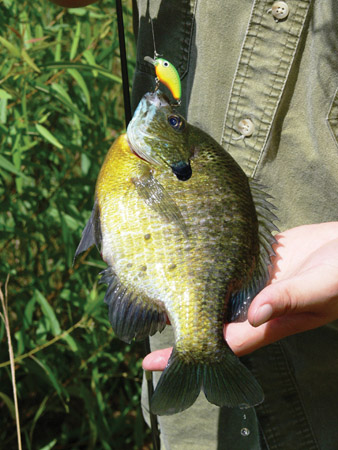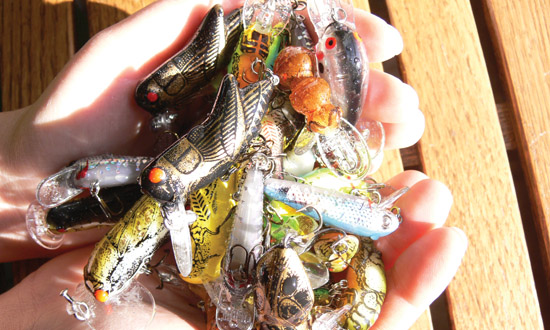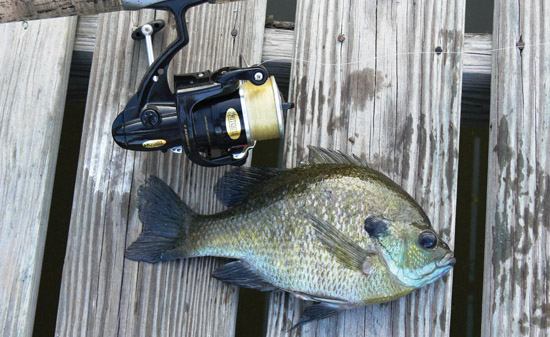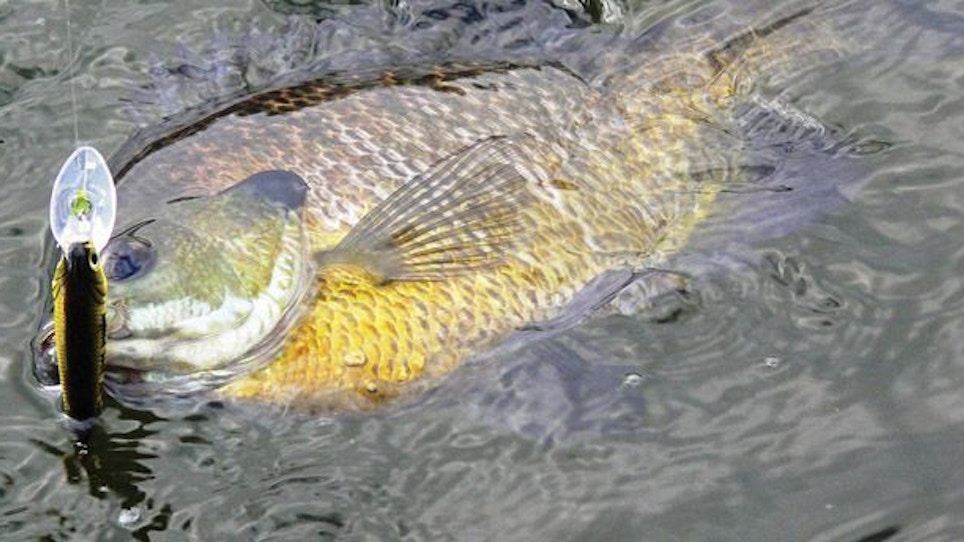 Bream-sized crankbaits are being produced by lure manufacturers in ever-expanding numbers and designs. Let’s look at the choices that tackle manufacturers offer anglers who are looking to tempt bull bream.
Bream-sized crankbaits are being produced by lure manufacturers in ever-expanding numbers and designs. Let’s look at the choices that tackle manufacturers offer anglers who are looking to tempt bull bream.
Bream-sized Crankbaits
One of the more appealing aspects of mini crankbaits is their versatility. Since the earliest versions of the smaller bait began to appear, anglers have discovered that they work well on all sorts of fish, including bluegills. The 2-inch-long Rapala Floating Minnow was one of the first small crankbaits used by anglers to target bream. This little fellow has been around a long time, and the gold-finished version has caught countless big bream.
Even though bream aren’t avid minnow eaters, they seem to love chomping down on these minnow look-alikes. Rapala’s HJ06 Husky Jerk is a reliable choice for big bream, and the countdown model gives anglers better depth control. The 1-inch-long countdown model suspends at any depth; you can run it on top or allow it to sink 13 feet. Anglers can target weed tops or sunken structures at specific depths.
Rebel is another company that has expanded its small crankbait line recently. The Rebel F4703 in a silver finish has proved to be irresistible to jumbo bluegills and strikes typically come when this little wiggler is paused during a steady retrieve. Even though the Rebel and Rapala minnow imitations look alike, their actions on retrieve are different, and bream tend to prefer one to the other sometimes. It’s best to have both options available for presentation.
Several lure companies make scaled-down versions of their standard larger bass crankbaits. Bomber Lures, for instance, makes a 1-inch crankbait that looks like a shrunken bass plug. These crankbaits are extremely effective on big bream, especially in the olive or red-belly finish.
Lure makers have also produced a dazzling array of mini crankbaits that represent crawfish, grasshoppers, frogs and other potential prey items. Rebel Lures specializes in these true-to-life crankbaits, offering mini-crawfish, grasshoppers, crickets, and even cicadas to tempt bream. And they all work. The lifelike finish catches the angler’s attention in the store, and the small size and erratic action of the plug catches the fish’s attention on the water.

Fishing insider Jeff Samsel recommends anglers try a range of the natural-looking mini cranks to see which works best in varying conditions. For a big splash, toss one of the Rebel grasshopper mini crankbaits under an overhanging limb or in the slower backwater section of a creek and hang on.
How to Fish the Crankbaits
Although bream love underwater cover and downed treetops, some of the biggest bluegills are caught in open water, where small crankbaits excel. Cast the lure as far as possible and retrieve at a steady pace. When open-water fishing, anglers must watch the line.
Often, bluegills will hit a crankbait at the end of a long cast so lightly that the angler doesn’t even feel the hit. The line might twitch, which should signal the angler to slow the retrieval. In open water, big bream often will hit crankbaits again until they finally get hooked. Another advantage to fishing open water with mini-cranks is that a lot of water can be explored fast.
Any visible underwater cover should be explored. A crankbait should be cast past the cover and pulled down to its optimum running depth. When the little swimmer gets alongside the cover, pause the retrieve to allow the bait to slowly rise or suspend. Bream love to attack a slow-rising bait. The closer a mini-crank is pulled to the cover without hanging up, the more likely a fat bluegill will hammer it.The final technique for catching big bream on a crankbait is Samsel’s favorite. It requires the angler to do nothing.

“Cast the little crankbait as far as possible, and then let it sit,” says Samsel. “Let the impact rings disappear. After several seconds, gently ‘bump’ the floating bait. This doesn’t require a hard jerk — just a light wrist snap to move the bait a whisker. Repeat the sit-still-and-wait technique, and then bump it again. Usually by this point, a bream will be on the line.”
Fishing Setup
Tiny crankbaits aren’t meant to be used with bass tackle. Anything heavier than 10-pound-test line will effectively kill the wiggle that makes these lures so effective. Also, the lures will not cast well on heavy line. The entire rig needs to match the weight and size of the lure. Putting a crankbait rig together for a bream is a bit of a balancing act. The rig must be delicate enough to allow maximum lure action and casting range, while at the same time provide enough strength to handle hefty fish.
A lightweight-spinning rod with a reel that handles 4- to 8-pound-test line is a good choice for mini-cranks. Of course, the lighter the line, the more action and depth the lure will achieve. Although these little crankbaits dance well on 4-pound-test line, don’t expect line that light to handle many bass in cover. Near cover, 8-pound-test line is a good compromise. It’s light enough to afford good lure motion, and it is heavy enough to provide at least a chance of landing the occasional bass.






